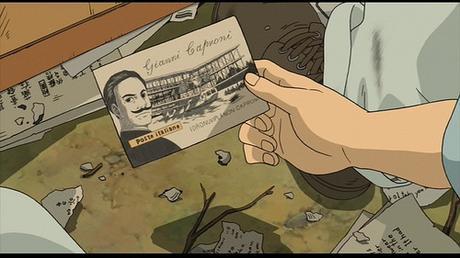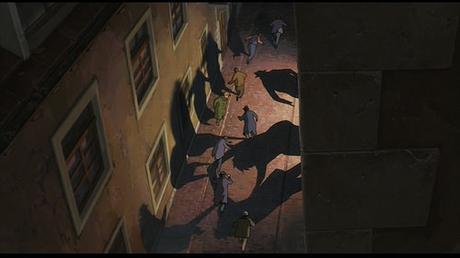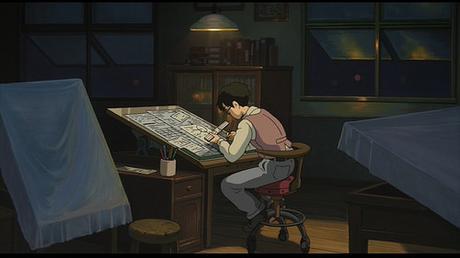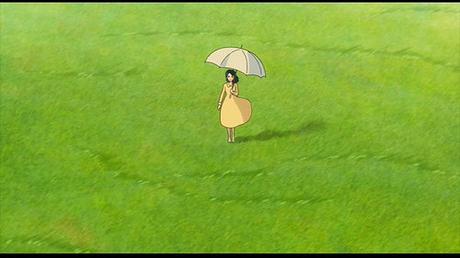No. One of the Caproni sequences isn’t a dream sequence and of the other three, yes, we can call two them dream sequences, but they differ from one another in significant ways. As for the last one, the one that ends the film, it’s not clear what it is. Though much of it takes place in the same green meadow as the two dream sequences, Miyzaki doesn’t mark it as a dream sequence. He doesn’t mark it at all. He just cuts to it.
First Caproni dream: Aeronautical Engineer
The first Caproni dream sequence, which is the second dream sequence in the film, begins with Horikoshi on the roof of his house looking up at the sky. He’s joined by his sister, who wonders why he isn’t wearing glasses. He says he’s heard that you can cure your vision by staring intently at the stars.

00:07:50
As they’re looking at what’s clearly a nighttime sky we see this, airplanes flying the colors of Italy in broad daylight:

00:08:00
And then we have one of the loveliest images in the film; that previous sky projected on Horikoshi’s face.

00:08:05
He then finds himself in a meadow of bright green grass, and wearing glasses.

00:08:11
He’s now in the dream realm, chasing in Caproni’s plane; that’s Caproni in the dark suit at the front of the plane. The plane is obviously a warplane – see the bombs slung beneath the wings?

00:08:43
Horikoshi clambers up into the plane and we have the body of the dream. The upshot is that, while he cannot be a pilot because of his eyesight, he can be an aeronautical engineer. Caproni himself has never flown a plane. We also see the nine-winged plane that will crash in the next Caproni sequence.
Now we’re entering the final phase of the dream. Again, notice Horikoshi’s glasses:

00:12:05
The camera cuts to an image of Horikoshi’s sleeping head, without glasses, and lying on a tatami mat. How did he get from the roof of the house staring up at the sky to lying on a tatami mat (and not a futon)? The movie says nothing about that and, I will also point out, I didn’t even notice this apparent lapse in continuity the first time I watched the film.

00:12:07
Of course, it is not a lapse at all. But what is it?
Back in the dream, all of a sudden it’s night. When and how did that happen? The dream was set in bright daylight, no?
Caproni: “Airplanes are beautiful dreams. Engineers turn dreams into reality.” Horikoshi (asleep on the tatami mat): “Yes!”

00:12:10

00:12:23
Caproni says goodbye. The camera’s point of view could easily be that of a boy lying on his back looking up at the moonlit sky. But that boy is lying on a tatami mat as his mother wakens him. Or is he? Where are we in time?

00:12:31

Mother: “Jiro, you were talking in your sleep. You were smiling. You must have been having the most wonderful dream, Jiro.” Horikoshi: “Mother, I’m going to be an aeronautical engineer.”
We get another shot of the sky in which we see Caproni’s nine-winged plane. Had it somehow escaped from dreamtime? Or is Miyazaki just playing around? Well, of course he’s playing around, but why?

00:13:05
In this sequence we seem to have time and space intermixed. Temporally, we move from early evening on the roof to morning on the tatami mat, without any explicit account of how we got from one to the other. By space I mean not physical space in the mundane world (from roof to tatami mat) and (metaphysical?) space in dreamtime.
In the dream sequence that opens the film Miyazaki tricked us at the opening, moving into dream footage without actually indicating that that’s what was going on. But he brought us out of it in a straightforward way. At one moment Horikoshi is falling out of the sky. The next moment we see him lying on his back on a futon, just about to awaken from sleep. In this sequence dreamtime and mundane-time are intercut at the beginning and end of the sequence.
Interchange: Keep Dreaming
The second apparent dream sequence isn’t a dream sequence at all, as I pointed out in The Wind Rises: A Note About Failure, Human and Natural [2]. Rather, we seem to have a real Caproni sequence intercut with a real Horikoshi sequence and the two men communicate with one another by talking loudly and shouting halfway around the world. The two sets of events would seem to be happening at the same time.
These events weren’t actually contemporaneous. The Caproni sequence involves the large nine-winged plane we saw in the dream sequence. Caproni takes it out for a test-run and it crashes. That happened on March 4, 1921 [3]. The Horikoshi sequence takes place during the Great Kanto earthquake of September 1, 1923 [4]. Miyazaki, however, intercuts them on screen in the same timeframe, and there are no indicators that either sequence is supposed to be dreamlike. While the film is based on historical events, it is not a documentary. Miyazaki uses his materials freely.
This whole sequence starts with young Horikoshi on a crowded train traveling back to college. He’s sitting outside a car at one end on the steps and reading a book. A girl comes out as a gust of wind comes by and she utters, “Le vent se lève” (“the wind is rising”) from a poem by Paul Valéry that gives the film its name. The wind catches his hat, she catches it, and he catches her as she almost falls off the train. He notes that she speaks French. “‘Le vent se lève?’ It’s a French poem.” “Il faut tenter de vivre” he replies, completing the line. The girl is Naoki Satomi. They’ll meet again a few years later when they’ll fall in love and get married. He repeats the whole line to himself once more.
Miyazaki is really hitting us over the head with the title of his film. He’ll do it again.
We see the earthquake developing:

00:15:54
It ripples through the land, to the train, causing it to derail, and beyond. The girl was traveling with a maid, who breaks her leg. Horikoshi carries her on his back to a place of safety. On the way we see this shot of the sky:

00:19:02
The burning debris is from the fires caused by the earthquake. But what are those planes with Italian markings doing in the Japanese sky?

00:19:17
After he’s gotten Naoko and her maid to safety Horikoshi continues on to his college where he meets his friend, Honjo, who is helping to rescue books from the library. While taking a breather from fighting the fire Horikoshi sees a postcard with Caproni’s picture on it and a picture of that plane he’d seen in his childhood dream.

00:22:51
“It’s as beautiful is it was in the dream. I can’t believe he really built it.” At that point we cut to this image of Caproni standing in a rowboat along with a photographer and a cameraman.

00:23:04
They’re filming the failed test of Caproni’s plane, which crashes [2].

00:24:01
As Caproni angrily stops the filming we cut back to the fires in Tokyo:

00:24:12

00:24:14

00:24:21
Cut back to Caproni: “What do you think, Japanese Boy. Is the wind still rising?” Cut back to Horikoshi, who is using his jacket to put out the flames: “Yes.”

00:24:25
Cut back to Caproni: “Well then you must live! Le vent se lève, il faut tenter de vivre.” (The wind is rising! We must try to live.) There it is again, the line from Valéry that gives the film its title. And Caproni was tossing film overboard as he uttered it:

00:24:28
We cut back to Tokyo:

00:24:32

The earthquake is over. The fires are out. People are tired.
What just happened, in the film? Why did Miyazaki cut these two very different scenes together? On the one hand we see that Caproni, Horikoshi’s hero and the one who inspired him in his vocation, has just gone through the failure of his own dream, and yet urges Horikoshi to live. As for Horikoshi and his world, that earthquake sequence is the most violent sequence in the film, though we will later see traces of the violence of World War II. Why cut these things together, along with the line of French poetry that gives the film its name and that links Naoko Satomi, Horikoshi, and Caproni?
It’s one thing to trace out the connections flowing through this sequence, it’s quite something else to understand, aesthetically, what’s going on. I could easily go on and on tracing those connections, which are obvious enough once you slow down and go through the film scene by scene. But getting a handle on the aesthetics, I’m not yet up to it, though I’ll take a crack at it in a later post.
Second Dream: A Beautiful Design
The second Caproni dream takes place a bit before the mid-point in the film, while Horikoshi is traveling on a train from Germany to...it’s never actually specified. But let’s first establish Horikoshi in Germany. He’s part of a Japanese delegation set to study German technology. We get the following shot of the countryside – but it’s surely no accident that Miyazaki showed a building with exotic onion-dome roofs. [BTW, does anyone know just what structure this is?]

00:45:15
Here we are at the Junkers plant, looking down from a huge plane at the Japanese delegation:

00:46:07

Now Horikoshi and Honjo are walking around inside the plane’s wing, when they come upon an engineering station:

00:49:18
And here they are back at their cozy room, trying to make sense of it all – Japan’s backwardness and Germany’s advanced technology.

00:51:27
They go out for a walk and encounter the secret police chasing someone. Notice the expressionist imagery:

00:53:05
Most of the Japanese delegation is recalled to Japan. Honjo remains at the Junkers factory while Horikoshi is sent on a tour of “the West”.
In the next frame we see him sitting in a train, looking out the window, and Caproni has joined him. He is not, however, asleep. This is not, in the ordinary sense, a dream. It’s more like a daydream or a reverie. Just exactly what it is isn’t so important as the fact that it is different from Horikoshi’s two previous encounters with Caproni.

00:55:03
Caproni urges him to jump from the train:

00:55:26
He lands in that same green meadow he’d encountered in the first Caproni dream, years ago (a meadow, incidentally, that seems kin to the meadow in Howl’s Moving Castle). He clambers into Caproni’s plane where he finds himself surrounded by people:

00:56:06
Caproni: “These are all of my workers and their families. Practically the whole village. I thought we’d take a little jaunt before we deliver this bomber to the government.” If you’ve seen Porco Rosso, you’ll remember that the workers who did the refit of Porco’s plane were also villagers and family.
Once again Horikoshi laments how poor and backward Japan is and so could never build anything like Caproni’s plane. Caproni: “Inspiration is more important than scale. Inspiration unlocks the future. Technology eventually catches up. That’s my family.” They’re in another, smaller, plane:

00:56:51
Caproni: “We Italians are very poor as well. Too many mouths to feed.”
Caproni takes Horikoshi for a walk on the plane’s topmost wing. It’s here that Caproni asks Horikoshi which he would prefer, a world with pyramids, or one without [5]. Caproni laments that, while humanity has always dreamed of flight, “the dream is cursed”. His own aircraft “are destined to become tools for slaughter and destruction.” “I know.” “But still, I choose a world with pyramids in it.” This is when Horikoshi “receives” his a plane design, the one that will become his first successful plane [6].
Caproni remarks that artists are only creative for ten years (where’d this come from?) and that engineers are no different. As he’s making this observation the camera zooms in on the sky (notice the propeller motion at the top left):

00:58:52
And then pans down to an aerial view of Nagoya:

00:58:54

The dreamtime sequence is over and Horikoshi is once again back at his drafting table at work:

00:59:02
The first Caproni dreamtime sequence picked up Horikoshi lying atop his house in the late evening and ended in the morning with him awakening from sleep on a tatami met. No indication was given of how he got there. In this sequence, Horikoshi starts in a train somewhere in Europe and ends up back at work in Japan. How’d that happen?
There is no answer and I suppose it doesn’t matter. What matters is that Miyazaki did it. What does that imply about, well, about what? Miyazaki’s aesthetic vision? His philosophy? His view of life? Something like that, perhaps.
This sequence leaves us midway through the film. Horikoshi will be appointed the chief designer of Mitsubishi’s next major project and Caproni will disappear until the very last sequence.
The Final Dream
This final sequence begins after the successful test flight of Horikoshi’s plane, the one based on the design he saw in the second Caproni dream, the A5M. As that test flight reaches a successful apex Horikoshi senses that his tubercular wife has died – at least that’s how I (and others) interpret a certain pause in that test. The pilot lands the plane to great applause, walks over to Horikoshi to thank him for the plane, and there is celebration all around. The camera zooms out so we see the plane and the men on the bright green test field:

01:59:03
We then cross fade into a sky filled with aerial bombardment, billows of smoke, and flames. In the few seconds of that fade we’ve moved forward half a dozen years to the end of World War II when Japan was being bombed by the Allies. But – and this just occurred to me – we don’t see atomic mushroom clouds. Those mushroom clouds are a motif in Japanese popular culture and in Japanese culture in general, but Miyazaki chose not to use them.
Why? I can’t see into his mind, but it seems possible to me that that possibility didn’t even occur to him. For those mushroom clouds belong to a narrative about Japan and the war that’s different from the one Miyazaki is invoking in The Wind Rises. The mushroom clouds belong to a narrative in which Japan is the victim of the most horrible weapon ever deployed in warfare. That narrative would interfere with the one Miyazaki is depicting in the film, Japan as aggressor.
The smoke and flame-filled sky gives way to a dark pile of war debris, buildings and planes, and then the sky lightens as we pan left:

01:59:47
We cut to grass and debris in a scene that looks a bit like Laputa in Castle in the Sky or even the regrowth at the end of Princess Mononoke.

02:00:08
Horikoshi is walking in the grass threading his way among the wreckage and sees Caproni at the top of a rise. He joins them there. Notice that, visually, we now have both the lush green field of the previous Caproni dreams crossed with the destruction of war. They chat about dreams, life, and losing a war.

02:00:31
We see a squadron of A6M Zeros, the plane Horikoshi is noted for, enter from the right. A pilot salutes them:

02:01:02

02:01:04
And they salute back. Why? Neither of them was in favor of war. Both regretted the use to which their nations put their engineering skills. Perhaps, nonetheless, they respected the skill and bravery of the pilots. The squadron passes, heading into a sky filled with planes (an image out of Porco Rosso):

02:01:19
They chat a bit, Caproni remarks: “Someone is waiting for you.” There’s his dead wife, Naoko, holding an umbrella like the one that shielded her when she was painting at the mountain resort:

02:01:49

02:02:05
Naoko: “You must live, darling. You must live.” Jiro: “Umm huh.”

02:02:09
The umbrella flies away...in a rising wind?...

02:02:16
...and she follows:

02:02:19
Caproni: “She was beautiful, like the wind.” Horikoshi: “Thank you, thank you.” Caproni: “But now, shall we drop by my house. I have some very excellent wine.”

02:02:32
What did we just see? Naoko was clearly dead. Caproni lived until 1957; Horikoshi until 1982. And the two never met. So in what metaphysical realm, what region of reality, are they going off to drink some wine together?
Recall that this sequence began with a successful test flight of a plane in mundane time-and-space. The camera then moved us through the end of the war, still in mundane time-and-space. But when we moved to a world of debris among green grass, now we’ve shifted in ontological space. That shift is confirmed by the appearance, first of Caproni, then of Naoko.
Is this a dream? Not in any ordinary sense. No one awakens from this dream. Rather, the film ends.
I submit that at the end of the film, that’s where we’re at, at the end of the film. This very film is the register of reality where these people meet and chat. It’s where the two men share a glass of wine, though we don’t actually see them do so.
I’ll return to this in a later post. Though I’m not guaranteeing that I’ll believe it in that post.
But before we leave this post, let me remind you of the general point: These encounters with Caproni are each staged in a different way. The first is staged as a dream, but Miyazaki obscures just how Horikoshi moves from the rooftop to a tatami mat inside the house. The second isn’t staged as a dream at all, but as the simultaneous occurrence of events on opposite sides of the world, with communication between Caproni (in Europe) and Horikoshi (in Japan). The third encounter is launched as a daydream that starts in Europe and carries us half way around the world back to Japan. This last encounter, well, I’m arguing that it happens in this film and only in this film.
References
[1] William Benzon. The Wind Rises, It Opens with a Dream: What’s in Play? New Savanna. November 8, 2015. URL: http://new-savanna.blogspot.com/2015/11/the-wind-rises-it-opens-with-dream.html
[2] The Wind Rises: A Note About Failure, Human and Natural. New Savanna. November 18, 2015. URL: href="http://http://new-savanna.blogspot.com/2015/11/the-wind-rises-note-about-failure-human.html
[3] Caproni Ca.60. Wikipedia. Accessed November 26, 2015. URL: https://en.wikipedia.org/wiki/Caproni_Ca.60
[4] 1923 Great Kantō earthquake. Wikipedia. Accessed November 26, 2015. URL: https://en.wikipedia.org/wiki/1923_Great_Kantō_earthquake
[5] William Benzon. Why Miyazaki’s The Wind Rises is Not Morally Repugnant. 3 Quarks Daily. November 16, 2015. URL: http://www.3quarksdaily.com/3quarksdaily/2015/11/is-miyazakis-the-wind-rises-morally-repugnant.html
[6] William Benzon. From Concept to First Flight: The A5M Fighter in Miyazaki’s The Wind Rises. New Savanna. November 11, 2015. URL: http://new-savanna.blogspot.com/2015/11/from-concept-to-first-flight-a5m.html

